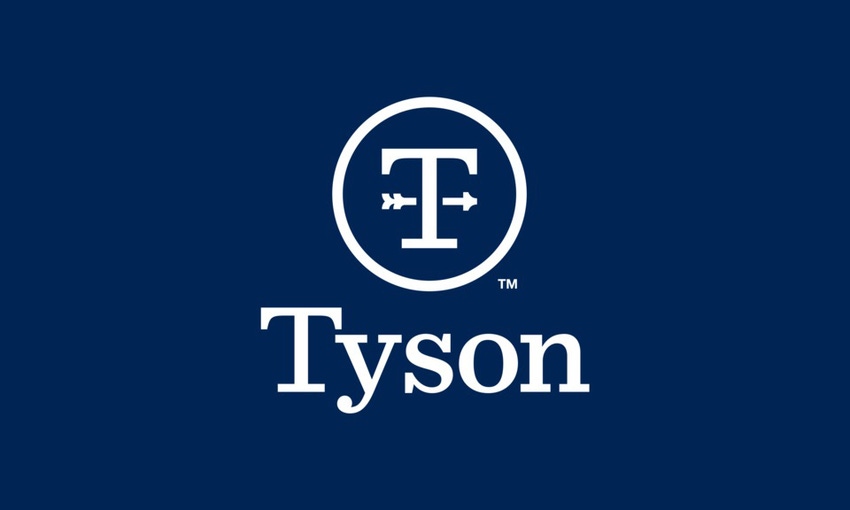Tyson Foods delivers strong sales, earnings growth
Company launching productivity program to save over $1 billion annually by the end of 2024.

Tyson Foods reported strong sales and earnings growth in its Q4 2021 results this week. Net income for the quarter was $1.36 billion, up from $654 million in Q4 2020. Net income for fiscal year 2021 was $3.05 billion, up from $2.06 billion in 2020. Sales for Q4 2021 were $12.81 billion, up from $10.64 billion during the same quarter in 2020.
“We delivered double digit sales and earnings growth during the fourth quarter and full year, and our performance was supported by our diverse portfolio and continued strength in consumer demand for protein,” said Donnie King, president and chief executive officer of Tyson Foods. "We delivered a record performance in our beef segment and experienced share gains in our retail core business lines, which include our Tyson, Jimmy Dean, Hillshire Farm and Ball Park iconic brands, while supporting the continued recovery in foodservice.”
In addition to announcing improved results, the company also announced a new savings initiative.
“To foster continuous improvement and faster decision making, we’re launching a new productivity program designed to deliver more than $1 billion in annual savings by the end of 2024,” King said. “The focus of this plan includes operational and functional excellence, digital solutions, and automation and advanced technologies.”
Specifically, the company said it is targeting $1 billion in productivity savings by the end of fiscal 2024 and $300 million to $400 million in fiscal 2022, relative to a fiscal 2021 cost baseline.
King continued, “We have tremendous opportunity ahead as we work to fulfill growing global demand for safe and nutritious protein products. We’re entering fiscal 2022 with great momentum and are committed to delivering strong returns for shareholders into the future.”
COVID-19 expenses
The company reported direct incremental expenses associated with the impact of COVID-19 totaling approximately $65 million and $335 million for the fourth quarter and twelve months of fiscal 2021, respectively. The expenses primarily included team member costs associated with worker health and availability including direct costs for personal protection equipment, production facility sanitization, COVID-19 testing and vaccinations, donations, product downgrades, rendered product and certain professional fees, partially offset by CARES Act credits.
“We anticipate some of these direct incremental expenses to become permanent over time,” the company said. “Other indirect costs associated with COVID-19 are not reflected in these amounts, including costs associated with raw materials, distribution and transportation, plant underutilization and reconfiguration, premiums paid to cattle producers and pricing discounts.”
Segment results
In the Beef segment, sales volume decreased 15.4% during the fourth quarter of fiscal 2021, or decreased 8.8% after removing the impact of an additional week in 2020. The decline was due to the impact associated with a challenging labor environment, partially offset by strong global demand, the company reported.
Sales volume increased 0.3% during fiscal 2021, or increased 2.4% after removing the impact of an additional week in fiscal 2020, due to strong global demand, partially offset by the impacts associated with a challenging labor environment and severe weather.
According to the company, average sales price increased as input costs such as live cattle, labor, freight and transportation costs increased and demand for beef products remained strong. Operating income increased due to strong demand as the company continued to optimize revenues relative to live cattle supply, partially offset by production inefficiencies due to labor challenges.
Additionally, the company said operating income in fiscal 2021 was impacted by a cattle supplier's misappropriation of company funds, which resulted in a $55 million gain related to the recovery of cattle inventory as compared to a $106 million loss recognized in fiscal 2020.
Sales volume in the Pork segment also decreased, down 17.7% during the fourth quarter of fiscal 2021, or decreased 11.3% after removing the impact of an additional week in 2020, and decreased 2.7% in fiscal 2021, or decreased 0.8% after removing the impact of an additional week in 2020. As with the Beef segment, the declines in Pork were due to the impacts associated with lower hog supplies and a challenging labor environment, partially offset by strong global demand.
Average sales price increased as input costs such as live hog, labor, freight and transportation costs increased and demand for our pork products remained strong. Operating income decreased primarily due to lower hog supplies relative to industry capacity as well as production inefficiencies related to COVID-19 and a challenging labor environment, partially offset by a reduction in direct incremental expenses related to COVID-19 in fiscal 2021 as compared to fiscal 2020. Additionally, volatile market conditions resulted in net derivative losses of $90 million in fiscal 2021 and net derivative gains of $70 million in fiscal 2020, which were offset by the impacts of related physical purchase transactions.
Chicken segment sales volume decreased 5.9% during the fourth quarter of fiscal 2021, or increased 1.3% after removing the impact of an additional week in 2020, primarily due to increased demand in the foodservice channel. Sales volume decreased 3.3% for fiscal 2021, or decreased 1.5% after removing the impact of an additional week in 2020. Despite a strong demand environment, volume decreased due to the impacts associated with a decline in hatch rate, a challenging labor environment and disruptions due to severe weather in the second quarter of fiscal 2021.
Average sales price increased due to favorable sales mix and inflationary market conditions. Operating income decreased during the fourth quarter of fiscal 2021 primarily due to $325 million of higher feed ingredient costs, $75 million of net derivative losses in the fourth quarter of fiscal 2021 as compared to $45 million of net derivative gains in the fourth quarter of fiscal 2020, increased supply chain costs and a $23 million expense related to a fire at a production facility, partially offset by favorable product mix.
Operating income decreased during fiscal 2021 primarily due to a $626 million loss from the recognition of legal contingency accruals, $735 million of higher feed ingredient costs as compared to fiscal 2020, increased supply chain costs, $23 million of expenses related to a fire at a production facility, decline in hatch rate and disruptions due to severe weather. This was partially offset by favorable product mix, reduced direct incremental expense associated with COVID-19 and $65 million of net derivative gains in fiscal 2021 as compared to $50 million of net derivative losses in fiscal 2020.
Outlook
For fiscal 2022, the USDA indicates domestic protein production (beef, pork, chicken and turkey) should increase slightly as compared to fiscal 2021 levels. Tyson provided a summary of the outlook for each of its segments, as well as an outlook for revenues, capital expenditures, net interest expense, liquidity, tax rate and dividends for fiscal 2022.
On the beef side, USDA projects domestic production will decrease approximately 2% in fiscal 2022 as compared to fiscal 2021. Tyson anticipates another strong year with adjusted operating margin between 9-11% in fiscal 2022. It also expects the first half of the fiscal year will be stronger than the second half as a combination of higher utilization and demand for cattle may result in a narrowing spread.
USDA projects domestic pork production will decrease approximately 2% in fiscal 2022 as compared to fiscal 2021. Tyson believes its Pork segment's adjusted operating margin will be 5-7% in fiscal 2022.
For chicken, USDA projects chicken production will increase slightly in fiscal 2022 as compared to fiscal 2021. Tyson anticipates an adjusted operating margin at the lower end of 5-7% for fiscal 2022.
Lastly, the company projects its adjusted operating margin in its Prepared Foods segment will be around 7-9% in fiscal 2022 and said it will remain disciplined in its pricing initiatives to ensure additional inflationary pressures are passed through to customers. Additionally, the company said it will also work diligently to deliver productivity savings to reduce costs.
About the Author(s)
You May Also Like





